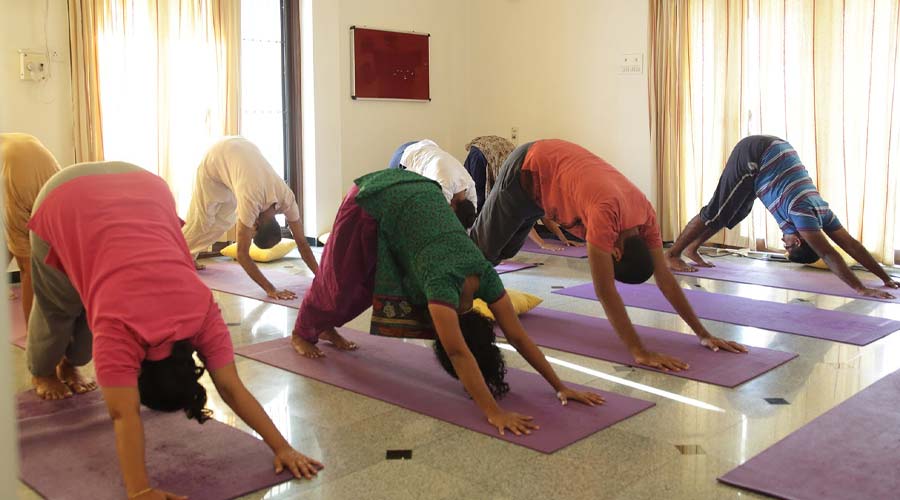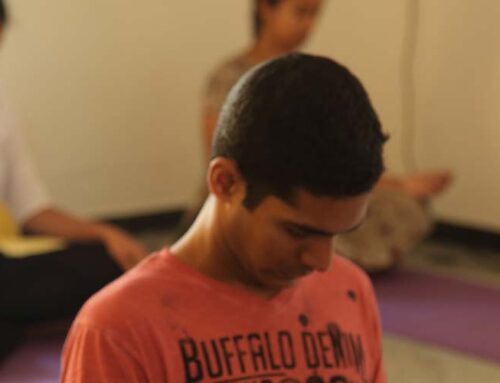December 2016 Life Positive Magazine
By Saraswathi Vasudevan (www.yogavahini.com)
Long and deep exhalation can lower your blood pressure, reduce pain, improve sleep, and facilitate healing of the body quite effortlessly, says Saraswathi Vasudevan
Breathing is the fundamental cleansing process of the system. When we breathe efficiently, we release a lot of impurities and end products of metabolism allowing all organs, systems and cells to receive fresh nourishment through the blood. When breathing is inefficient, we accumulate the waste products that toxify the system and prevent fresh intake of nutrients.
Exhale first!
Yoga Sutra says one of the ways to calm the mind is to focus on exhalation, and retention after exhalation (YS 1.34). Good exhalation reactivates the parasympathetic response, shifting the system from sympathetic domination (stress mode). When the mind calms down and becomes quiet, we begin to conserve prana that is wastefully dispersed through incessant thinking and strong emotional reactions.
Exhalation helps relax the muscles that may be held tight because of inherent stress response. When muscles relax, flexibility improves, general aches and pains come down and the breath expels waste products from muscles and joints to be eliminated through the breath!
If you can extend your exhalation long and deep, you can lower your blood pressure, reduce pain, improve sleep and facilitate healing of the body quite effortlessly. All you have to do is breathe out long and deep!
How to exhale efficiently?
Lie down in a comfortable position with your legs bent so that your lower back and abdomen are relaxed. Pay attention to your natural breathing. When you begin to observe your breath, it is no more natural, it becomes slightly longer and deeper. Observe where you are able to feel the movement. With natural breathing – like a baby asleep – abdomen goes up on inhalation and relaxes on exhalation.
Exhalation is a passive process in normal breathing but in yogic deep breathing, we make exhalation more active! To facilitate good exhalation and emptying of air from the lower lobes of the lungs where 75-80 per cent of gaseous exchange takes place, we actively but gently draw the lower abdomen in and up, simultaneously relaxing the chest. The diaphragm gets pushed up and the lungs are emptied more efficiently. Make sure you are not holding up the chest while drawing the abdomen in.
Once you get the technique right, begin to extend the exhalation by gently slowing down the movement of the lower abdomen and chest. You can begin with 3 seconds exhalation and extend up to 6 or 8 seconds, to the extent you are comfortable and there is no strain in the body. Do this practice in seated position (on a mat/chair), extending exhalation.
As you draw the lower abdomen in and up, the often overarched (lordosis) and strained lower back flattens and relaxes. The organs in the abdomen are squeezed out so that they can receive fresh oxygenated blood with the next inhalation. The floor of the perineum is lifted up, toning the lower abdominal muscles and reinstating the organs that are pulled down with gravity. The technique helps to pull the lower chakras up, thereby allowing the circulation of prana, and removal of impurities that are accumulated in the lower abdominal area. You start feeling lighter in your body and mind as the breath is trained to flow out slowly, smoothly, unimpeded.
Try this technique every night before you go to bed, to prepare for a beautiful day ahead!
About the author: Saraswathi Vasudevan is a yoga therapist trainer in the tradition of Sri T Krishnamacharya. She specialises in adapting yoga to the individual.
20th June 2017


